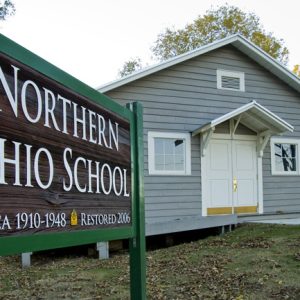calsfoundation@cals.org
Northern Ohio Cooperage and Lumber Company
The Northern Ohio Cooperage and Lumber Company was a sawmill that produced lumber and barrel staves on the banks of the St. Francis River just north of the town of Parkin (Cross County). The Northern Ohio sawmill was located on the Parkin Mound Site that is now Parkin Archeological State Park. The Northern Ohio Cooperage and Lumber Company operated throughout the first half of the twentieth century, from 1902 until its closure by 1946. The only historic building associated with the sawmill that is still standing is the rehabilitated one-room Northern Ohio School.
The property that became the Northern Ohio Cooperage and Lumber Company was first owned by Beaufort Neely in 1820. The original survey journal descriptions of the area around the St. Francis River noted the vast amount of softwood and hardwood, especially cypress. However, the first sawmill on this site was reportedly owned by two brothers, George and Jake Maddox (or Mattox), in 1890. Through a series of sales, timber buyers from Columbus Grove, Ohio, bought this land to create the Northern Ohio Cooperage Company.
The Northern Ohio Cooperage Company was organized in 1902 with Charles H. Jones as president and George W. Core as vice president; both men were from Columbus Grove. S. W. Sterling, also from Ohio, was sent by Jones and Core to purchase property and timber and to manage the future facility. Another sawmill, adjacent to the Northern Ohio, was the Parkin Cooperage Company, owned and operated by Henry Coldren, who was also from Ohio. The Parkin Cooperage Company opened in 1906. The two companies merged to form the Northern Ohio Cooperage and Lumber Company sometime between 1910 and 1911. In 1916, the company expanded out of the Cross County area into Poinsett County in a deal for 7,300 acres for $220,000 dollars. This deal reportedly offered around 50,000,000 feet of hardwood.
In 1918, Henry Coldren bought S. W. Sterling’s share of the Northern Ohio. This was the first move by the Coldren family to control the Northern Ohio Cooperage and Lumber Company. This process was complete in the late 1920s when Henry Coldren bought the majority stock in the sawmill from the original stockholders. The Northern Ohio Cooperage and Lumber Company finally closed by the end of 1948, and some of this land was merged into Roy Coldren, Inc., to be developed into plantations.
The Northern Ohio controlled an extensive area surrounding the St. Francis River. Built on top of a former Native American village site, the Northern Ohio sawmill provided housing and stores for its workers, who largely resided on top of the archeological site. Among these buildings was the Northern Ohio Schoolhouse, offered as a way for the workers’ children to attend school near their home. After the Northern Ohio closed, many of the sawmill workers stayed, forming what is locally known as the Sawdust Hill community. The Coldren family, which retained ownership of the Native American mound, donated it to the city in 1964. There also remains a community by the name of Northern Ohio in Poinsett County. It was established by the company to cut hardwood stands on the St. Francis River there, with its own smaller sawmill.
For additional information:
Balogh, George W. Entrepreneurs in the Lumber Industry: Arkansas, 1881–1963. New York: Garland Publishing, Inc., 1995.
Bragg, Don. “Cypress Lumbering in Antebellum Arkansas.” Arkansas Review: A Journal of Delta Studies 42 (December 2011): 185–196.
Chowning, Robert W. History of Cross County, Arkansas. Wynne, AR: Wynne Progress, 1955.
Clements, William M., and Larry D. Ball. “‘This was the beginning of Clearing of Land’: The Development and Use of the East Arkansas Stump Saw.” Arkansas Historical Quarterly 45 (Spring 1986): 41–52.
Kinder, George D. History of Putnam County, Ohio: Its Peoples, Industries, and Institutions: With Biographical Sketches of Representative Citizens and Genealogical Records of Many of the Old Families. Indianapolis: B.F. Bowen and Co., 1915.
“Northern Ohio School.” National Register of Historic Places nomination form. On file at Arkansas Historic Preservation Program, Little Rock, Arkansas. Online at http://www.arkansaspreservation.com/National-Register-Listings/PDF/CS0191.nr.pdf (accessed October 13, 2020).
“Northern Ohio School: Historic Structure Report and Stabilization Plan.” Prepared for the Arkansas Department of Parks and Tourism by Steelman, Connell, Mosely, Architects. Dean B. Ellis Library Archives and Special Collections. Arkansas State University, Jonesboro, Arkansas.
“Operations on St. Francis River.” The Barrel and Box 24, no. 1 (March 1919): 38.
Oral History Interviews on the History of Sawdust Hill Community. On file at Parkin Archeological State Park, Parkin, Arkansas.
Whayne, Jeannie. Delta Empire: Lee Wilson and the Transformation of Agriculture in the New South. Baton Rouge: Louisiana State University Press, 2011.
Zachary Elledge
Jonesboro, Arkansas
 Business, Commerce, and Industry
Business, Commerce, and Industry Early Twentieth Century, 1901 through 1940
Early Twentieth Century, 1901 through 1940 Northern Ohio School
Northern Ohio School 




Comments
No comments on this entry yet.